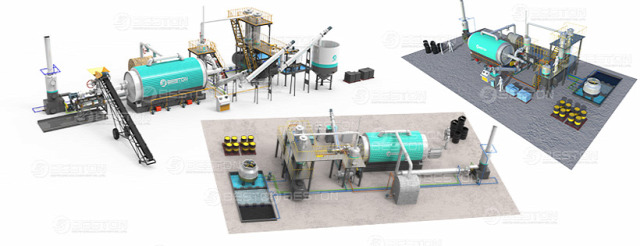In an era of increasing environmental awareness and sustainability, the need for innovative recycling solutions has never been greater. One such solution that has gained significant attention and traction in recent years is tire pyrolysis recycling. This process involves converting discarded tires into valuable materials such as oil, carbon black, and steel wire through a high-temperature pyrolysis reaction. In this comprehensive guide, we will delve into the key benefits of investing in a great waste tyre recycling pyrolysis plant.

Sustainable Source of Raw Material
The first and foremost advantage of investing in a tire pyrolysis recycling machine is the consistent and abundant source of raw material – used tires. As long as vehicles continue to be an integral part of transportation systems worldwide, the production of tire waste remains an ongoing process. Whether due to wear and tear from everyday use or seasonal factors like winter road conditions, tires have a limited lifespan. This continuous supply of tire waste ensures a stable source of raw material for recycling, making it a lucrative and sustainable investment.
High-Value End Products
One of the distinguishing features of tire pyrolysis recycling is its ability to generate high-value end products. Unlike traditional recycling processes, pyrolysis can yield valuable materials such as:
a. Fuel Oil: Pyrolysis machines can transform tire waste into fuel oil, which is in high demand across various industries. This oil can be used as a substitute for conventional fuels, making it a cost-effective and eco-friendly option.
b. Carbon Black: Carbon black, a fine powder produced during the pyrolysis process, has numerous industrial applications, including tire production, plastics manufacturing, and ink production.
c. Steel Wire: Tire recycling machines can efficiently separate and recover steel wire from tires, which can be sold as a valuable raw material to steel mills.
The ability to generate these high-value materials significantly enhances the profitability of tire pyrolysis recycling, making it a sound investment choice.
Low Operating Costs
When considering an investment in machinery, it's essential to evaluate not only the initial purchase price but also the long-term operating costs. Tire pyrolysis equipment stands out in this regard due to its cost-effectiveness. Several factors contribute to the low operating costs associated with this machinery:
a. Energy Efficiency: Modern pyrolysis machines are designed to be energy-efficient, minimizing energy consumption during the tire-to-oil conversion process.
b. Minimal Maintenance: Pyrolysis equipment typically requires minimal maintenance, resulting in reduced downtime and maintenance expenses.
c. Labor Efficiency: Many pyrolysis machines feature automatic feeding systems, reducing the need for extensive manual labor and further lowering operational costs.
These cost-saving aspects make tire pyrolysis recycling an attractive and sustainable venture for investors.
Diverse Range of Options
Investors seeking to enter the tire recycling industry will find a wide array of pyrolysis equipment options available in the market. This diversity allows investors to choose machinery that aligns with their production goals, budget constraints, and specific needs. Whether you opt for a small-scale pyrolysis plant or a large-scale production facility, there is machinery suitable for every requirement. Additionally, the availability of various price points ensures that investors can find cost-effective options without compromising on performance.
Environmentally Responsible
Beyond its economic advantages, tire pyrolysis recycling contributes significantly to environmental conservation. By diverting used tires from landfills and incineration, pyrolysis helps mitigate the adverse environmental effects of tire disposal. Furthermore, the process is designed to minimize emissions and pollutants, making it an eco-friendly recycling solution.
Conclusion
Investing in a tire pyrolysis recycling machine offers a plethora of benefits, from a sustainable source of raw material and high-value end products to low operating costs and environmental responsibility. As the demand for recycled materials continues to rise, the tire recycling industry holds substantial potential for profitability. By carefully considering your production goals, researching available options, and understanding the cost-efficiency of tire pyrolysis machinery, you can make a well-informed investment decision that aligns with both your financial and environmental objectives. Tire pyrolysis recycling is not just a smart investment; it's a step towards a greener and more sustainable future.

